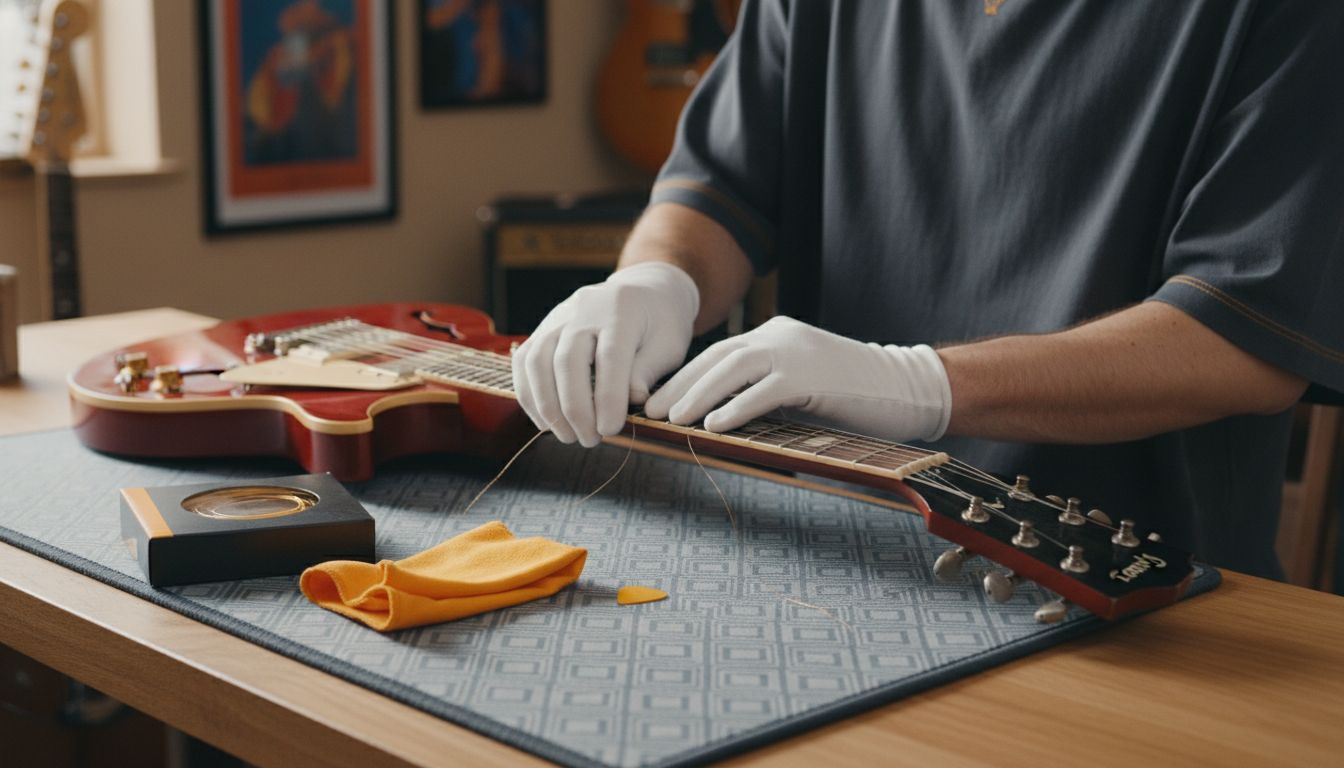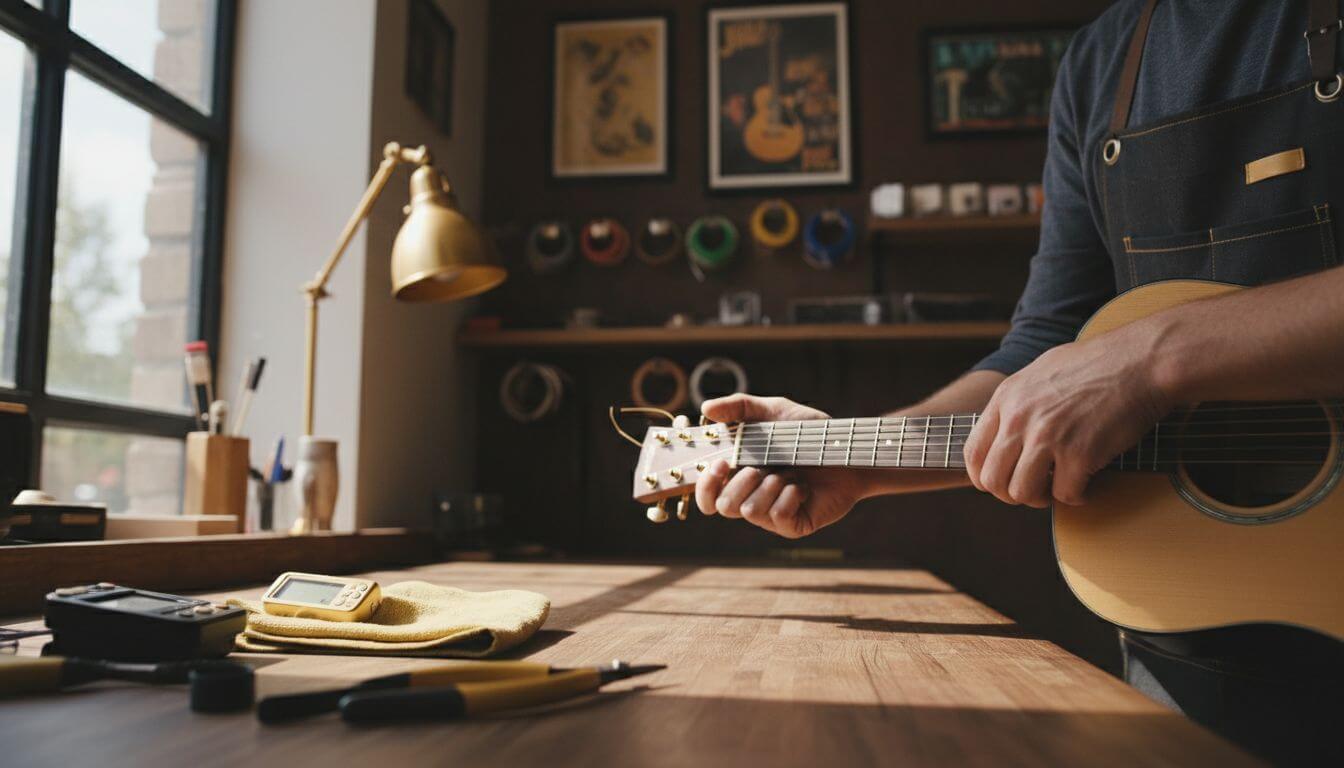Did you know that over 70 percent of guitarists experience trouble with tuning stability after changing strings? Proper restringing can make all the difference in how your guitar feels and sounds. Having the right tools and mastering a few simple techniques makes restringing not just easier, but also ensures your instrument performs at its best every time you play.
Table of Contents
- Step 1: Assemble The Essential Restringing Tools And Supplies
- Step 2: Remove Old Guitar Strings With Care
- Step 3: Clean The Fretboard And Inspect Hardware
- Step 4: Install New Strings Using Proper Techniques
- Step 5: Tune And Stretch The New Strings Evenly
- Step 6: Check String Stability And Adjust For Playability
Quick Summary
| Key Point | Explanation |
|---|---|
| 1. Gather essential tools pre-restringing | Collect a string winder, wire cutters, tuner, and cloth to ensure an effective restringing process. |
| 2. Safely remove old strings | Loosen strings gradually and unwind carefully to avoid damaging your guitar’s finish during removal. |
| 3. Clean fretboard and inspect hardware | Use a microfiber cloth to clean and inspect all components, ensuring optimal guitar condition before new strings. |
| 4. Install strings with precision | Thread new strings accurately and ensure proper winding tension for stable tuning and improved sound quality. |
| 5. Tune and stretch new strings | Use an electronic tuner, stretch strings gently, and repeat tuning to ensure pitch stability and consistent playability. |
|
Step 1: Assemble the essential restringing tools and supplies
Before diving into the guitar restringing process, you will need to gather a collection of specific tools that will make your job smoother and more efficient. According to guitar maintenance experts, having the right equipment is crucial for achieving a professional restringing outcome.
Your essential toolkit should include several key items: a string winder for rapid and consistent string installation, precision wire cutters for trimming excess string length, an electronic tuner to ensure pitch accuracy, and a soft cleaning cloth to prepare and maintain your guitar’s surfaces. Learn more about must-have guitar accessories to enhance your setup.
Here’s a summary of the essential restringing tools and their key features:
| Tool | Purpose | Key Features |
|---|---|---|
| String Winder | Speed up string installation | Ergonomic design Smooth rotation |
| Wire Cutters | Trim excess string length | Sharp blades Guitar-specific cuts |
| Electronic Tuner | Ensure pitch accuracy | Precise tuning Easy to read |
| Cleaning Cloth | Prepare & maintain guitar surfaces | Soft material Lint-free |
A quality string winder will save you significant time and prevent hand fatigue during the restringing process. Look for a winder with an ergonomic design that fits comfortably in your hand and provides smooth rotation. Your wire cutters should be sharp and designed specifically for guitar strings to ensure clean, precise cuts without fraying.
Pro Tip: Always keep your tools organised and within easy reach before starting the restringing process to maintain a smooth workflow.
Before proceeding, ensure your workspace is clean, well-lit, and provides enough room to manoeuvre. Having all your tools prepared will set you up for a successful restringing experience and help you achieve optimal guitar tone and playability.
Step 2: Remove old guitar strings with care
Removing your guitar’s old strings requires a careful approach to prevent potential damage to your instrument. In this step, you will learn how to safely detension and remove the strings while protecting your guitar’s delicate finish.
According to guitar maintenance experts, the first crucial step is to turn each tuning peg counterclockwise, gradually loosening the strings until they become slack. This methodical approach prevents sudden tension release that could potentially harm your guitar. Check out our guide on changing guitar strings for additional insights into the process.
Once the strings are sufficiently loose, carefully unwind them from the tuning pegs and bridge. Be mindful of your guitar’s finish during this process to avoid scratching or causing any unintended marks. Work systematically from the lowest to the highest string, maintaining a gentle touch throughout the removal.
Pro Tip: Consider wearing soft cotton gloves to provide an extra layer of protection for your guitar’s surface while removing strings.
Remove each string completely, taking care not to let them drag across the guitar body. By following these careful steps, you will ensure a smooth transition to your new set of strings and maintain your instrument’s pristine condition.
 Get ready to prepare your guitar for the next exciting stage of the restringing process.
Get ready to prepare your guitar for the next exciting stage of the restringing process.
Step 3: Clean the fretboard and inspect hardware
With the old strings removed, you now have the perfect opportunity to give your guitar some much needed attention and maintenance. This crucial step involves thoroughly cleaning the fretboard and carefully examining the instrument’s hardware to ensure everything is in optimal condition.
According to guitar maintenance experts, start by using a soft, lint-free microfiber cloth to gently clean the fretboard. Carefully remove any accumulated dust, dirt, and grime without applying excessive pressure that might damage the wood. Check out our guide to keeping your guitar in top condition for additional maintenance insights.
Next, conduct a comprehensive inspection of all hardware components. Carefully examine the tuning pegs, bridge, and other metal parts for any signs of wear, corrosion, or potential damage. Look closely at the tension of mounting screws, the condition of saddles, and ensure that all moving parts are functioning smoothly.
Pro Tip: Use a small torch or bright light to help you spot minor imperfections that might be difficult to see in normal lighting conditions.
Take your time during this inspection. A thorough examination now can prevent potential issues down the line and help maintain your guitar’s overall performance and playability. With the fretboard clean and hardware checked, you are now ready to move on to the next exciting stage of restringing your instrument.
Step 4: Install new strings using proper techniques
With your guitar prepared and cleaned, you are now ready to breathe new life into your instrument by installing fresh strings. This critical stage requires precision and careful technique to ensure optimal sound quality and tuning stability.
According to guitar maintenance experts, begin by threading each new string through the bridge and up to the corresponding tuning peg. Pay close attention to the alignment and ensure each string is seated correctly in the nut and bridge slots. Learn more about professional guitar setups to understand the nuanced details of string installation.
Start with the lowest string and work your way up, leaving a generous amount of slack for winding. As you route each string, guide it through the appropriate tuning peg hole and begin winding clockwise. Aim for approximately 3 to 4 clean wraps around the peg, ensuring the string winds downward neatly and consistently.
Pro Tip: When winding strings, keep consistent tension and ensure each wrap sits neatly beside the previous one to prevent potential slippage or uneven tuning.
Carefully trim any excess string length once you have wound and seated each string, leaving just enough to prevent unwinding. Your methodical approach now will result in improved tone, sustain, and overall playing experience. Get ready to tune and fine tune your newly strung guitar.
Step 5: Tune and stretch the new strings evenly
You are now in the final stages of your guitar restringing process, where precision and patience will ensure your instrument sounds its absolute best. This crucial stage involves carefully tuning your new strings and helping them settle into their optimal playing condition.
According to guitar maintenance experts, start by using an electronic tuner to bring each string up to its correct pitch. Learn more about electric guitar string techniques for additional insights into achieving perfect tuning. Begin with the lowest string and work your way up, making incremental adjustments until each string rings true.
Once tuned, gently stretch the strings by pulling upward slightly away from the fretboard. This technique helps new strings stabilise and reduces the likelihood of them slipping out of tune during initial playing. Be careful not to pull too hard which might damage the string or cause unnecessary tension.
Pro Tip: Repeat the tune and stretch process two or three times to ensure maximum string stability and consistent pitch across all strings.
Play the guitar for a short period, retuning as necessary, to allow the strings to settle and adapt to the instrument. This process might take 10 to 15 minutes of gentle playing, during which you will notice the strings gradually becoming more stable and maintaining their tuning more consistently.
Step 6: Check string stability and adjust for playability
With your new strings installed and initially tuned, the next critical phase is ensuring your guitar plays smoothly and sounds fantastic. This step involves carefully evaluating the overall setup and making precise adjustments to optimize your instrument’s performance.
According to guitar maintenance experts, begin by checking the action and intonation of your guitar. Explore our comprehensive guide to professional guitar setups for detailed insights into fine tuning your instrument. Play each string across the fretboard, listening carefully for any buzzing or inconsistent sound that might indicate alignment issues.
Carefully examine the truss rod and bridge to ensure proper string height and alignment. Make small incremental adjustments to prevent excessive string buzz while maintaining a comfortable playing feel. The goal is to create a balanced setup where the strings are neither too high nor too low on the fretboard.
Pro Tip: When making adjustments, turn adjustment screws in quarter turn increments and test the guitar after each small change to avoid overcorrecting.
Ensure that the strings are properly seated in the nut and bridge slots, providing a smooth playing experience with consistent pitch and minimal friction. Your meticulous attention to these details will result in a guitar that not only sounds great but feels incredible to play.
Elevate Your Guitar Care with Expert Tools and Support
Struggling to find the right tools or unsure how to keep your guitar sounding its best after restringing It can be tough to achieve that perfect tone and playability without professional guidance or quality supplies The article highlights common hurdles such as proper string installation, tuning stability, and hardware maintenance—challenges every guitarist faces when refreshing their instrument. Whether you need precision wire cutters, reliable string winders, or an electronic tuner to perfect your setup, accessing premium gear is key to success.

Explore our carefully curated selection of guitars and accessories at MusicStreet.co.uk where high-end, meticulously checked instruments and must-have restringing tools await. Dive into expert advice provided through our comprehensive guides including How to Change Guitar Strings and Pro Setup Guide to master every step confidently. Enhance your tone and playability today—visit us online or at our Huntingdon store for setup services and support that empower your musical journey.
Frequently Asked Questions
How do I clean the fretboard before restringing my guitar?
To clean the fretboard, use a soft, lint-free microfiber cloth to gently remove dust and grime. This will help maintain the wood’s quality and improve playability.
What steps should I follow to safely remove old guitar strings?
Loosen each string by turning the tuning pegs counterclockwise until they are slack, then carefully unwind them from the tuning pegs and bridge. Avoid dragging the strings across the guitar’s surface to prevent scratches.
How do I install new strings correctly for optimal tone?
Thread each new string through the bridge and up to the corresponding tuning peg, leaving enough slack to wind 3 to 4 wraps around the peg. Ensure the strings are seated properly in the nut and bridge slots to improve tuning stability and sound quality.
How can I stretch new guitar strings to maintain tuning?
Gently stretch each new string by pulling upward slightly from the fretboard after tuning them to pitch. Repeat this process two to three times to help stabilize the strings and reduce the chance of slipping out of tune.
How do I adjust my guitar for optimal playability after restringing?
Check the action and intonation by playing each string across the fretboard and listening for buzzing. Make careful quarter-turn adjustments to the truss rod or bridge height to achieve a comfortable playing feel and avoid pitch issues.
What tools do I need for restringing my guitar effectively?
Gather a string winder, precision wire cutters, an electronic tuner, and a soft cleaning cloth. Having these tools ready will streamline your restringing process and help achieve a professional result.




Share:
7 Essential Types of Acoustic Guitars Explained for Musicians
What Is a Capo? Complete Guide for Guitarists